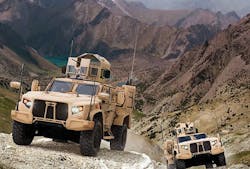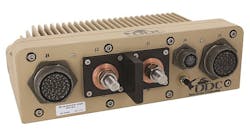Oshkosh Defense chooses vetronics solid-state power controllers from DDC for military JLTV
Oshkosh officials have awarded a contract of undisclosed value to DDC to provide SSPC power distribution units and modules for the JLTV program, DDC officials announced Tuesday at the Association of the U.S. Army (AUSA) conference and trade show in Washington.
The JLTV family of vehicles is a Joint U.S. Army, Marine Corps, and Special Operations Command program that provides vehicles and companion trailers to fill several mission roles while providing protected and networked mobility for warfighters and their equipment.
The JLTV incorporates dramatic electrical power use improvements over previous generations of light military vehicles, such as the existing Humvee, DDC officials say. U.S. military leaders say they expect to order 55,000 JLTVs over the course of the program's lifetime.
JLTV will use scalable armor to protect soldiers, Marines, and their equipment Military leaders and Oshkosh vehicle designers are emphasizing commonality of components, maintenance procedures, and training between all variants to keep costs down. The vehicle can be sling-loaded aboard Army CH-47D heavy-lift helicopters, as well as aboard Marine Corps CH-53E cargo helicopters.
Related: Army makes quarter-billion-dollar JLTV armored combat vehicle order to Oshkosh Defense
DDC SSPCs enable network control, programmability, and autonomous operation to simplify vehicle control and free crew members to concentrate on mission-critical tasks, DDC officials say.
DDC’s SSPCs offer reduced size, weight, and power consumption (SWaP) compared with mechanical power switches, breakers, and relays to save space for other components and expanded functionality.
The company's SSPCs enable a 7X power-to-volume and 5X power-to-weight savings, compared with larger mechanical alternatives, enabling reduced space consumption and fuel costs, while extending mission range, DDC officials say.
The power units also offer a 70 percent reduction in power dissipation, along with energy savings through intelligent load shedding and prioritization.
Related: Oshkosh chooses Telephonics NetCom vetronics communications system for JLTV program
DDC SSPCs have a 25X improved mean time between failures (MTBF) compared with mechanical switches, breakers, and relays, with moving parts which are more prone to failure, company officials say.
They also provide real-time health and diagnostic data for improved mission uptime, safety, and longevity through preventive and automated maintenance.
In federal fiscal year 2017 alone, which began on 1 Oct., U.S. military leaders say they plan to buy 2,020 JLTVs at a cost of $735.4 million.
For more information contact DDC online at www.ddc-web.com, or Oshkosh Defense at http://oshkoshdefense.com.
Learn more: search the Aerospace & Defense Buyer's Guide for companies, new products, press releases, and videos


